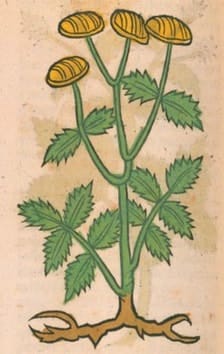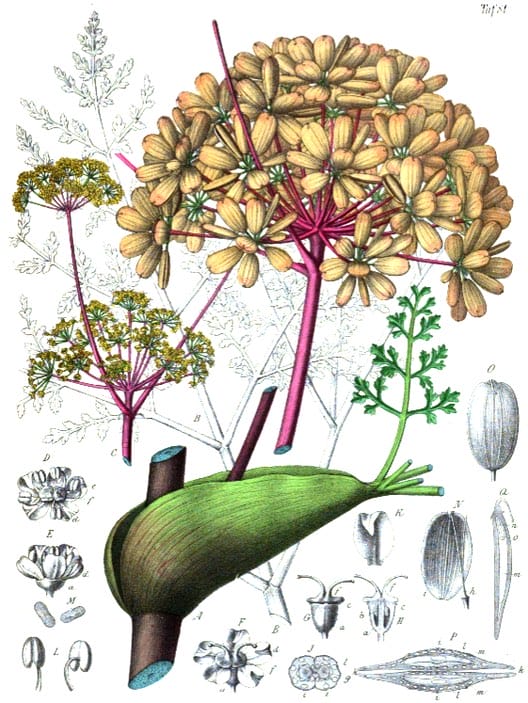Galbanum‘Syrian Ferula’, Fennel Giant, MetopiumJaosheer (Unani) Kamashir (Avicenna) |

|
 Ortus Sanitatis, Meydenbach, 1491
Ortus Sanitatis, Meydenbach, 1491 Atlas der officinellen pflanzen (2), Felix, 1899
Atlas der officinellen pflanzen (2), Felix, 1899BUY GALBANUM

Botanical name:
Ferula galbaniflua (syn. F. rubricaulis, Bubon galbanum)
Parts used:
Gum
“The best gum is characterised by a highly Bitter taste, White interior and Saffron coloured exterior, brittleness and solubility in water”. (Avicenna)
Temperature & Taste:
Warm, dry. Pungent, Bitter, aromatic
“Hot and dry in the Second degree”. (Avicenna)
Classifications:
2B ATTENUATERS. 2K. RESOLVENT. 2L. EMOLLIENT. 2M. DRAWING. 2Q. ANODYNE
3G. EMMENAGOGUE
4f. SPLENETIC. 4k. ARTHRITIC
Uses:
1. Moves Blood and Qi, Promotes Menstruation:
-Amenorrhea, Dysmenorrhea
-obstruction and hardness of the Uterus
-expels Birth and Afterbirth; a piece the size of a bean is given with wine for protracted labor. (Pliny)
-as a pessary to expel a Dead Fetus
-“forcefully discharges Menses, expels the Fetus and causes abortion when taken as a pessary” (Avicenna)
-“a potent Ecbolic drug. It is matchless in this respect” (Avicenna)
2. Clears Cold-Phlegm, Stops Cough:
-chronic and persistent Coughs, Wheezing, Asthma from Cold-Phlegm
–Pliny said it was used alone for inveterate Coughs and Asthma
-“useful in Asthma and chronic Cough” (Avicenna)
-chronic Lung Ulcers (Syrian “Book of Medicine“, trans. by Wallis Budge, 1913)
3. Clears Phlegm, Resolves Masses:
-softens hard swellings, useful in Scrofula (Avicenna)
-hardness of the Abdomen or Uterus
-“dissolvent and attenuant” (Avicenna)
-topiocally to all sorts of hardness
4. Clears Wind-Phlegm, Stops Spasms:
-Dizziness, Vertigo from Wind-Phlegm
-Spasms, Convulsions
-Wind-Damp Arthritis and Rheumatism, spasms of the sniews
–Pliny said the odor of it was useful for Epilepsy and Hysteria.
-“Its intake with wine is useful in Hysteria” (Avicenna)
5. Clears Damp, Moves Qi, Warms the Stomach:
-Poor digestion from Cold or Damp
-said to increase weight in the thin
-Hernia
6. Resists Poison
-Chills of Fevers and Intermittent Fever
-“It counteracts all kinds of Poisons” (Avicenna)
-arrow poison (Dioscorides)
-applied topically to resist venomous Bites, including those of Snakes (Pliny)
-“It is useful against the elfect of Snake and Scorpion poisoning.” (Avicenna)
7. Externally:
-promotes Delivery, for suffocation of the Uterus (in pessaries)
-applied with vinegar to remove Birthmarks (Dioscorides)
-Headache and Migraine
-applied as a collyrium to restore the sight
-kneaded into a hollow tooth to relieve Toothache (Dioscorides, Avicenna)
-applied to Sciatica and Nodes of the Joints (Pliny)
-as a plaster for Arthritic pain and Gout (Avicenna)
-Scrofulous Sores and Denudation of the Bones (Pliny)
-applied to Scorpion Stings (Pliny)
-Chronic, Malignant and Rodent Ulcers, applied with Honey. (Avicenna)
-Dandruff
Dose:
250–1000mg
Substitute:
1. Asafetida
2. Gum Ammoniac (Galen, Avicenna)
3. “Sagapen is the substitute for Galbanum” (Avicenna)
4. Fig (Avicenna)
Main Combinations:
1. Cough from Cold:
i. Galbanum with Storax, Myrrh, Opium (as in Expert Pills for Cough)
ii. violent Cough, Galbanum, Fennel seed, Opium, Honey (Syrian “Book of Medicine“, trans. by Wallis Budge, 1913)
iii. Galbanum with Storax, Opium, Sulphur, Terebinth, Black Pepper (as in Pills Proven for Coughs)
iv. Galbanum with Saffron, Licorice, Cinnamon, Spikenard, Storax, Opium, Myrrh, Aniseed (as in Antidote Appropriate for Cough)
2. Hoarseness of the Throat, Galbanum, Bitter Almonds, Myrrh, Storax, Opopanax, Saffron (Syrian “Book of Medicine“, trans. by Wallis Budge, 1913)
3. Cold Phlegm obstructing the Lungs:
i. Galbanum with Gum Ammoniac, Rhubarb, Licorice
4. Phthisis, and for coughing up Blood and Pus, Galbanum, Saffron, Acacia, Orris, Pomegranate flower, Costus, Storax, Dates (Syrian “Book of Medicine“, trans. by Wallis Budge, 1913)
5. Pleurisy, pain in the Lungs, coughing of Pus and Blood, Galbanum, Cinnamon, Costus, Poppy juice, Black and Long Pepper, Storax, Honey (Syrian “Book of Medicine“, trans. by Wallis Budge, 1913)
6. Lung Ulcers, melt Galbanum and Honey and give as a linctus (Syrian “Book of Medicine“, trans. by Wallis Budge, 1913)
7. To increase weight in the thin, take Galbanum with Goat Milk. (Syrian “Book of Medicine“, trans. by Wallis Budge, 1913)
8. Amenorrhea:
i. Galbanum with Myrrh, Iron sulphate, Cinnamon, form pills with Syrup of Orange peel
ii. Galbanum with Valerian, Iron, Savin
9. To promote Birth, Galbanum with Pennyroyal, Mugwort, Cassia Fistula, Saffron, Cinnamon, Myrrh (as in Powder to Facilitate Birth)
10. To expel a dead fetus, Galbanum and Myrrh taken with Wine. (Pliny)
11. Against Poison, Galbanum with Myrrh and Wine (Dioscorides, Pliny)
12. Internal Abscess, Galbanum, Gum Ammoniac, Sarcocolla gum, Sugar Penids; powder, mix with honey, the boil together with wine until the gums are dissolved, then strain and give to the patient to drink. (Syrian “Book of Medicine“, trans. by Wallis Budge, 1913)
13. Chronic Liver Hardness, Galbanum, Storax, Costus, Almond gum, Stacte, Laurel berry, Pepper, Opium (Syrian “Book of Medicine“, trans. by Wallis Budge, 1913)
14. Head Ulcers, Galbanum with Honey topically (Pliny)
15. Rodent Ulcers, Galbanum with Honey topically (Avicenna)
16. Suppuration of the Ears, Galbanum with Oil of Roses (Pliny)
17. Ear ache and poor hearing, Galbanum, Aloes, Myrrh, Frankicense, Bitter Almonds, Saltpeter. Beat to a powder; mix with Oil of Roses and drop in for strong ear pain; mix with vinegar and dropped in for poor hearing. (Syrian “Book of Medicine“, trans. by Wallis Budge, 1913)
Major Formulas:
Troches for the Womb
Pills Proven for Coughs (Galen)
Expert Pills for Cough
Antidote Appropriate for Cough
Antidote Proven for Diverse Diseases (Nicholas)
Beautiful Anodyne Antidote
Electuarium Acharistum (Nicholas)
1, Compound Pills of Galbanum:
i. Galbanum, Gum Ammoniac (1 dram each), Syrup, sufficient to form a pill mass. Make 30 pills.
ii. Galbanum (1 oz.), Myrrh, Sagapen (1 ½ oz. each), Asafetida (half oz.), Syrup (sufficient). Form pills. (London)
iii. Galbanum, Opopanax, Myrrh, Sagapen (1 oz. each), Asafetida (half oz.), Syrup of Saffron, sufficient to make pills.
2. Tincture of Galbanum:
i. Galbanum (2 oz.), Proof Spirit (2 pints). Digest 7 days, filter.
ii. Galbanum (1 part), Rectified Spirit (5 parts)
3. Compound Tincture of Galbanum:
i. Tincture of Galbanum, Tincture of Wormwood, Spirit of Rosemary (equal parts). Mix. Dose: 40–50 drops in a spoonful of water. (Pharmacopoeia extemporanea, Augustin, 1822)
4. Foetid Water (Aqua Foetida)
i. Galbanum (1 ½ oz.), Asafetida (6 drams), Valerian (1 oz.), Angelica (½ oz.), Zedoary (3 drams), Cumin (half oz.), Myrrh (6 drams), Mentha crispa (1 oz.), Peppermint, Wild Thyme (½ oz. each), Camomile (2 oz.), Water (5 lbs.), Proof Spirit (1 lb.). Digest, distil 3 pounds.
Dose: 1 spoonful. (Pharmacopoeia extemporanea, Augustin, 1822)
5. Plaster of Galbanum:
i. Turpentine (5 oz.), Yellow Wax (8 oz.); melt together, then add Galbanum dissolved in vinegar and evaporated (1 pound), Mix. (Pharmacopoeia extemporanea, Augustin, 1822)
6. Compound Plaster of Galbanum:
i. Simple Plaster (50 parts), Yellow Wax, Resin, Turpentine (3 parts), Gum Ammoniac (2 parts), Galbanum, Sagapen (1 part each). Melt the plaster in a water-bath; put the other ingredients into a pot with 4 parts of water and when dissolved express into the liquified plaster and stir until cold. (Formulaire Pharmaceutitique a l’usage des Hospitaux Militaires de France, 1821)
ii. Simple Plaster (1 lb.), Melt slowly and add: Gum Ammoniac, Galbanum (1 oz. each) dissolved in Vinegar (1 oz.), then add Saffron (1 ½ drams) and Mix. (Dispensatorium Pharmaceuticum, 1777)
Cautions:
1. Not used during Pregnancy
2. ‘It is thought to cause difficult Micturation’ (Dioscorides); Strangury (Pliny)
3. Avicenna noted it is not good for the Nerves unless affected by Damp.
Main Preparations used:
Purified Galbanum (dissolved in liquor, strained and dehydrated), Distilled Oil
-
Extra Info
-
History
|
‘We have already given some description of galbanum: to be good, it should be neither too moist nor too dry, but just in the state which we have mentioned. It is taken by itself for inveterate coughs, asthma, ruptures, and convulsions; and it is employed externally for sciatica, pains in the sides, inflamed tumours, boils, denudations of the bones, scrofulous sores, nodes upon the joints, and tooth-ache. It is applied with honey also, to ulcerations of the head. In combination with oil of roses or with nard, it is used as an injection for suppurations of the ears; and the odour of it is useful for epilepsy, hysterical suffocations, and faintness at the stomach. Employed as a pessary or as a fumigation, it brings away the foetus in cases of miscarriage; branches too of hellebore covered with it and laid beneath the patient, have a similar effect. |
‘We have already stated that serpents are driven away by the fumes of burnt galbanum, and they will equally avoid persons whose body has been rubbed with it. It is curative also of the sting of the scorpion. In protracted deliveries, a piece of galbanum the size of a bean is given in one cyathus of wine: it has the effect also of reducing the uterus when displaced, and, taken with myrrh and wine, it brings away the dead foetus. In combination with myrrh and wine too, it neutralizes pqisons—those which come under the denomination of “toxica” in particular. The very touch of it, mixed with oil and spondylium, is sufficient to kill a serpent. It is generally thought to be productive of strangury.’ (The Natural History of Pliny, trans. by Bostock and Riley, Vol. 5, 1856) |
